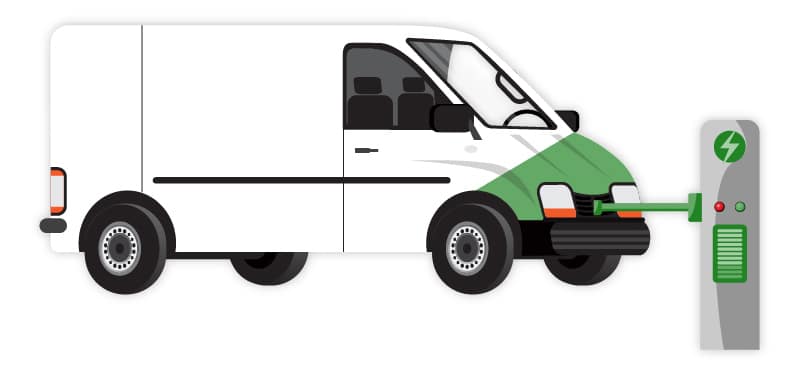
The EV Revolution is Here
High fuel prices, greater fuel efficiency, and concerns of the impact of fossil fuels are spurring the growth of consumer electric vehicles (EV) in the United States and across the globe.
As a result, the long-discussed EV revolution is no longer just over the horizon. It’s already here.
In the very near future, EVs will become one of the most cost-effective solutions for commercial fleet services, but there are some factors to consider before adding them to your fleet, including the impact they have on the trucking industry as a whole.
As auto companies invest more and in the personal EV market, the commercial side is starting to catch up.
Going Green – For the Environment and the Wallet
Why the acceleration of EV adoption in the vehicle fleet industry? The risks and costs of climate change.
According to the Environmental Protection Agency, greenhouse gas (GHG) emissions from the transportation sector account for over one-quarter of total U.S. greenhouse gas emissions of total U.S. greenhouse gas emissions, making it the largest contributor of U.S. GHG emissions. Between 1990 and 2020, GHG emissions in the transportation sector increased more in absolute terms than any other sector.
Commercial and government fleets are “going green” to reduce their carbon footprint and save money.
To achieve these goals, step one is to replace conventional vehicles with electric vehicles. Not only do EVs reduce emissions, but they also cut their maintenance and operating costs. The federal government’s eGallon calculator shows that an EV costs less than half its gasoline counterpart to go the same distance.
While it’s true that EVs are currently more expensive than gas-powered vehicles, there are generous federal incentives to encourage the switch to EVs, balancing out higher purchase costs.
The $1.2 trillion Infrastructure Investment and Jobs Act (IIJA), which focuses on transportation and energy as the top two sectors, and the Inflation Reduction Act (IRA) provide billions in tax credits to help fleets adopt EVs. Two stand out:
Qualified Commercial Clean Vehicles Tax Credit: A new tax credit providing up to $7,500 for vehicles with a gross weight up to 14,000 pounds, and up to $40,000 for heavier vehicles. Unlike the modified personal vehicle tax credit, the commercial version does not impose battery and critical mineral manufacturing and sourcing requirements, making it much easier to find the right EV.
Alternative Fuel Vehicle Refueling Property Tax Credit: This tax credit provides an incentive for developing EV chargers. Specifically, for EV chargers deployed in either low-income communities or outside of urban areas, a credit of 6% of project costs is available, which can increase to 30% for projects using prevailing wages and meeting certain apprenticeship requirements. The maximum credit value is $100,000 per charger.

So, You Want to Electrify Your Fleet? Start with Telematics!
As we’ve established, there’s no doubt that EVs are becoming an important part of fleet operations conversation and future planning. The big question is: how do we get there?
With concerns about total cost of ownership, infrastructure requirements, vehicle utilization and which vehicles in the fleet are viable for replacement with an EV, fleet managers are relying on accurate telematics data to provide a starting point.
Initial planning really requires a lot of data and that’s where traditional telematics comes into play. There are hundreds of data points that need to be evaluated and, for fleet managers, that can be overwhelming and virtually impossible without a connected data source.
The transition to an electric fleet takes careful planning, buy-in from key stakeholders, and new expertise, even for seasoned fleet managers with decades of experience under their belts. Thankfully, as EVs continue to gain market share and leading fleets from both the public and private sectors procure more EVs, successful transition strategies have become clear.
Fleet assessments
Comprehensive fleet assessments help you understand opportunities and sequencing for fleet electrification.
These assessments catalog the current fleet, documenting vehicle make and model, age, mileage, vehicle identification number, department, parking location, and other details, to provide a baseline from which to consider electrification opportunities. Much of this information is readily available with the right telematics solution.
Sustainability initiatives
Fleet managers must rely on accurate telematics data to provide a starting point on sustainability initiatives, including idle time, route efficiency, and regular maintenance.. Initial planning really requires data, and that’s where GPS tracking comes into play.
There are hundreds of data points that need to be evaluated before adding more EVs to fleets, and GPS tracking technology can help fleet managers decide what vehicles to electrify first, and what vehicles can be pushed off to a later date.
Costs
EVs are different than traditional gas-powered vehicles and will require different tires. Electric vehicles generate immediate power and acceleration, so tires must be able to fully withstand this difference. EVs are also heavier than internal combustion engines because of their batteries, so your tires must withstand more weight, while ensuring wear resistance and durability.
The tires of electric vehicles wear 20% faster than those of internal combustion engines. Fleet managers must take these issues into account as they make their plans.
Future
Electric vehicles are not a fad, they’re the future of fleet transportation. They will play a leading role in commercial and government fleets. Fleet companies have much to gain from electrifying their fleets, including reduced air pollution and lower operating, maintenance, and fuel costs.
Electrifying your fleet requires detailed planning and a commitment to getting ahead of the curve. GPS Insight can help fleet managers improve efficiency, productivity, safety, and customer service by helping them implement electric vehicles.





